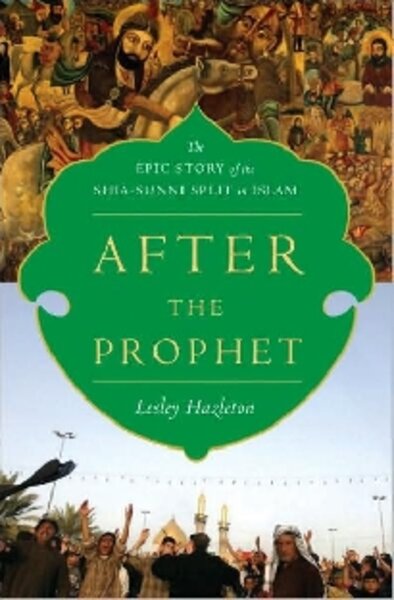After the Prophet
Loading...
As a child, I was roused by my father every weekend for Sunday school, held in the basement of our mosque with 50-odd unruly children. There, we were sent off to one of four cordoned-off sections of the basement where we sat on orange and blue plastic folding chairs and listened as our teacher – often an “aunty” or “uncle” from the community – lectured us on the Koran, Arabic, or – my favorite subject – stories full of hardship and triumph, the seerah, or life of our prophet Muhammad.
Those stories about Muhammad and the early years of Islam are still among my favorites, which is why I picked up Lesley Hazleton’s After the Prophet: The Epic Story of the Shia-Sunni Split in Islam. Hazleton, a Middle East journalist and author of several books on religion and history, draws from the work of 10th-century Islamic historian al-Tabari, to piece together a tale of the volatile relationships and political machinations that occurred after the death of Muhammad in 632. These are the events that would eventually lead to the great Shiite (Shia)-Sunni cleft in Islam which continues to play out today in sectarian violence throughout the Muslim world.
Hazleton begins where Sunday school left off, with the death of Muhammad, introducing the book’s central figures, Aisha, Muhammad’s favorite wife, and Ali, his cousin and son-in-law. She takes us through the caliphates of Abu Bakr, Omar, Uthman, and Ali, and, some 50 years later, to the tragic massacre of 72 warriors led by Muhammad’s grandson Hussein at Karbala, a pivotal event in Shiite history.
A Sunday school story it is not. Hazleton pits Aisha and Ali against each other in a bitter rivalry, paints a picture of calculating collusion among several of Muhammad’s close companions who would later be appointed caliph, and spares no gruesome details in the recreation of battles in which warriors were disemboweled, mutilated, and trampled.
Unfortunately, some of Hazleton’s depictions appear to be amplified merely for narrative drama, as in the case of the rivalry between Aisha and Ali, or based on unconfirmed assumptions, as in the case of collusion among Muhammad’s companions.
Regarding the rivalry between Muhammad’s wife Aisha and his cousin Ali, Hazleton’s bias is obvious. She calls Aisha, a woman revered in Islam as the “Mother of the Faithful,” “mean-spirited,” “headstrong,” and “used to having things her way.” Ali, on the other hand, she terms a “noble warrior,” “a man of integrity ... reluctant to compromise his principles.” The prejudice is blatant and offensive. Hazleton relies on numerous sources to create the basic outline of her narrative, but seems to fill in the blanks with her own opinions and commentary.
Even more troubling are the inaccuracies and assumptions. Hazleton writes that Aisha was “the first wife [Muhammad] married after the death of Khadija.” In fact, Sawda bint Zamah was the first wife he married after Khadija. She also writes that the Koranic revelation on veiling “clearly applied only to the Prophet’s wives ... and would eventually be enforced by Islamic fundamentalists convinced that it should apply to all women.”
That’s a misreading of the Koran and Muslim tradition no matter how you look at it. It is agreed throughout the Muslim world that the “Revelation of the Curtain” – which requires male companions to speak to the prophet’s wives only through a veil – does, in fact, apply only to the prophet’s wives. But it’s a different passage that deals with hijab, or veiling, and when it comes to interpreting that passage a majority of mainstream Muslim scholars – and many Muslim women, myself included – do believe it is compulsory for all Muslim women.
Hazleton’s description of 7th-century Arabian society, however, is illuminating. Here, she explains the centrality of poetry to Arab life. “[The poets] were the gossip columnists, the op-ed writers, the bloggers, the entertainers of the time.... Laced with puns and double entendres, [their satires] were irresistibly repeatable, building up momentum the more they spread. The barbed rhyming couplets acted like lances, verbal attacks all the more powerful in a society where alliances were made on a promise and a handshake, and men were literally taken at their word.”
The book excels in its central aim, explaining the Shiite-Sunni schism, the sense of disinheritance Shiites feel about their history, and the violent implications this has had on modern politics. At its simplest, the schism stems from a disagreement over who should have succeeded Muhammad after his death. Shiites believe Ali was the rightful hereditary heir; Sunnis believe Abu Bakr was the rightful elected leader.
Sunni readers like myself will appreciate Hazleton’s insight into the Shiite mind. “They had been disinherited, deprived of what they saw as their rightful place, the leadership of Islam. And this sense of disinheritance would sear deep into Shia hearts and minds, a wound that would fester through to the 20th century ... and erupt first in the Iranian revolution, then in civil war in Lebanon, and then, as the 21st century began, in the war in Iraq.”
As sectarian aggression flares in Iraq, Hazleton’s explanation of its deep, entrenched roots is essential. Too often, however, her inaccuracies, biases, and assumptions suggest a shallow and sometimes partisan understanding of Islamic history, and for many careful readers, threaten her credibility.
Husna Haq was an intern at the Monitor.






